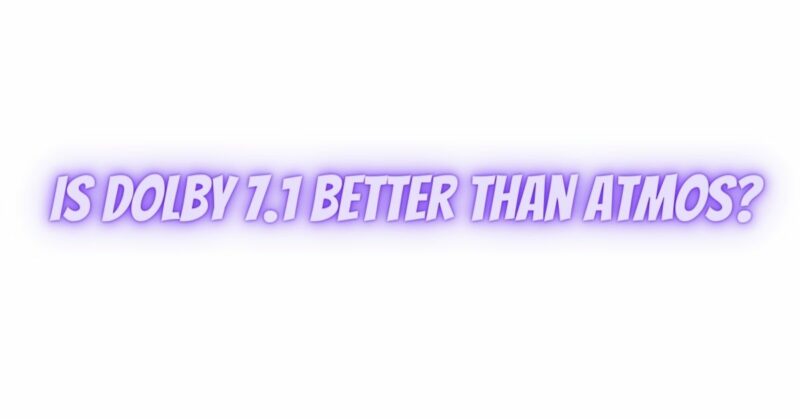When it comes to home audio systems, Dolby has been at the forefront of creating immersive sound experiences for both movies and music. Two popular audio formats are Dolby 7.1 and Dolby Atmos, each offering unique advantages. In this article, we’ll compare Dolby 7.1 and Dolby Atmos to help you understand the differences and determine which one may be better suited for your home theater or audio setup.
Dolby 7.1: The Classic Surround Sound
Dolby 7.1, also known as 7.1-channel surround sound, has been a standard in home theater audio for years. It is characterized by seven discrete audio channels:
- Front Left
- Front Center
- Front Right
- Rear Left (or Surround Left)
- Rear Right (or Surround Right)
- Rear Surround Left (or Surround Back Left)
- Rear Surround Right (or Surround Back Right)
The “.1” in 7.1 represents the dedicated subwoofer channel, responsible for reproducing low-frequency effects and delivering deep bass. Dolby 7.1 offers an immersive audio experience with clear directional cues, making it ideal for movies and gaming.
Dolby Atmos: Elevating the Audio Experience
Dolby Atmos is a revolutionary audio format that takes immersive sound to the next level. Unlike traditional 7.1 or 5.1 systems, Dolby Atmos is not limited to channel-based audio. Instead, it introduces the concept of audio objects and overhead sound.
In Dolby Atmos, sound is treated as individual objects, each with its own position in 3D space. This allows sound to move freely around the listener, including from overhead, creating a truly immersive audio experience. Dolby Atmos can support various speaker configurations, including 5.1.2 (5 main channels, 1 subwoofer, and 2 overhead channels) or more elaborate setups.
Advantages of Dolby Atmos:
- Heightened Immersion: Dolby Atmos provides a more lifelike and immersive audio experience, allowing sounds to come from all directions, including above.
- Precise Sound Placement: Audio objects in Dolby Atmos can be precisely positioned, making it easier to create a sense of movement and directionality in sound.
- Adaptability: Dolby Atmos is compatible with a wide range of speaker configurations, from soundbars with upward-firing drivers to elaborate home theater setups.
- Future-Proofing: As Dolby Atmos content becomes increasingly prevalent in movies, TV shows, and gaming, investing in Dolby Atmos ensures that your audio system remains relevant for years to come.
Choosing Between Dolby 7.1 and Dolby Atmos:
- Budget: Dolby Atmos systems can be more expensive due to the need for additional speakers, including overhead ones. If you have a limited budget, Dolby 7.1 is still an excellent choice for immersive sound.
- Room Size: Consider the size and layout of your room. Smaller spaces may not fully benefit from the overhead sound capabilities of Dolby Atmos.
- Content: If you primarily consume content with Dolby Atmos support and want the most immersive experience, investing in Dolby Atmos is a wise choice.
- Future Plans: If you plan to upgrade your home theater system gradually, starting with a 7.1 system and later expanding to Dolby Atmos is a practical approach.
Conclusion
Both Dolby 7.1 and Dolby Atmos offer exceptional audio experiences, but they cater to different needs and budgets. Dolby 7.1 provides immersive surround sound with a dedicated subwoofer, making it suitable for movies and gaming. Dolby Atmos, on the other hand, takes audio to new heights with its overhead sound capabilities, delivering a more immersive and lifelike experience.
Your choice ultimately depends on your budget, room size, content preferences, and future plans. Regardless of which format you choose, both Dolby 7.1 and Dolby Atmos have the power to transform your home audio setup into a captivating experience, enhancing your enjoyment of movies, TV shows, and gaming.


